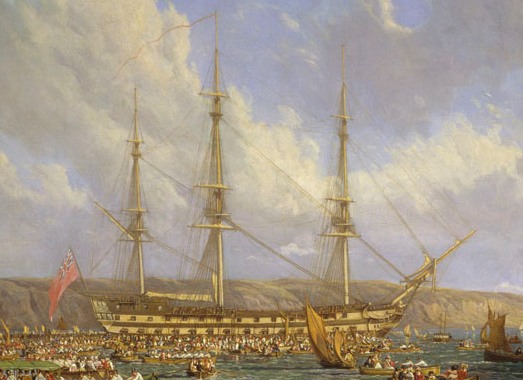Two hundred years ago today on the morning of July 15, 1815 the Emperor Napoleon Bonaparte boarded the HMS Bellerophon and surrendered himself to Captain Frederick Maitland announcing "I am come to throw myself on the protection of your Prince and your laws". The Bellerophon was part of the British naval squadron blockading the French port of Rochefort on the Atlantic Coast. Having participated in the three great French naval defeats of the Napoleonic Wars; The Glorious First of June (1794), The Battle of the Nile (1798) and Trafalgar (1805) the 74-gun Bellerophon, launched in 1786, was an appropriate site for the deposed emperor's surrender.
 (Captain Maitland)
(Captain Maitland)It was only twenty seven days since Napoleon's army had been shattered in the late afternoon and early evening at Waterloo. On June 21 the Emperor had returned to Paris but finding the political situation hopeless he abdicated the next day in favor of his son, the three year old King of Rome and became a loosely held prisoner of the provisional government at his mansion Malmaison. As the allied armies (British, Prussian, Austrian and Russian) neared Paris the Bourbon regime was reinstalled under King Louis XVIII and a formal armistice arranged with the provisional government on July 4.
In the meantime, Napoleon, fearing for his fate, requested the provisional government provide him with a frigate on which he could sail to America. Unable to get this he decided to proceed to Rochefort, where he arrived on July 3, hoping to find a ship to take him away from France. His fears were well founded. There is no doubt that Louis XVIII would order his summary execution if captured as would the Prussians and Austrians.
 (Bellerophon)
(Bellerophon)Rochefort was blockaded and Napoleon realized he would not make it to the United States (and if he had made it there it would have precipitated quite a diplomatic crisis for the new nation). Evaluating his options Napoleon convinced himself that surrendering to the British was his best option and thought they would agree to give him asylum and let him live in a country house in the English countryside!
On July 10, he sent two emissaries to the Bellerophon who met with Captain Maitland. Maitland was noncommittal regarding England's response other than to assure the emissaries that if Napoleon surrendered he would not be turned over to Louis XVIII. Based on this conversation, Napoleon decided to send a personal request for asylum to the Prince Regent (George III was having his last great fit of madness) which was delivered to Maitland on July 13:
Your Royal Highness
Exposed to the factions which distract my country, and to the enmity of the greatest powers of Europe, I have ended my political career, and I come, like Themistocles, to throw myself on the hospitality of the British people; I put myself under the protection of their laws, which I claim from Your Royal Highness, as the most powerful, the most constant, and the most generous of my enemies.
NapoleonMaitland accepted the letter (which did not reach the Prince Regent until late July) and announced his willingness for Napoleon to board the ship which would then sail to England, though he would not commit to any specific actions beyond that. Contributing to Napoleon's haste was news that on the night of July 14-15 a letter from Louis XVIII ordering the former emperor's arrest had reached authorities in Rochefort.
Rochefort, 13 July 1815
 (Napoleon on the Bellerophon, sketched in 1815 while in Plymouth Harbor from Art and Architecture)
(Napoleon on the Bellerophon, sketched in 1815 while in Plymouth Harbor from Art and Architecture) On July 24 Bellerophon anchored at Brixham on the Devon coast and Maitland received orders not to allow anyone to board the ship. He soon received orders to proceed to Plymouth, the English navy's main based on the Channel. Once again, no one was allowed aboard the ship and Napoleon was forbidden to disembark. However, news of his presence quickly spread and crowds flocked to the harbor to catch a glimpse of their long-time foe. Napoleon, ever the showman, would promenade on the deck each evening at 6pm waving to the crowds.
 (Sightseerers view Napoleon in Plymouth Harbor from Art and Architecture)
(Sightseerers view Napoleon in Plymouth Harbor from Art and Architecture) A local Plymouth paper reported disapprovingly (as quoted in Art and Architecture):
"On Sunday, we regret to say, a large proportion of spectators, not only took off their hats, but cheered him; apparently with a view of soothing his fallen fortunes, and treating him with respect and consideration. His linen sent ashore to be washed, has been held in much esteem, that many individuals have temporarily put on his shirts, waistcoats and neckcloths. Blind infatuation! Our correspondent, who was alongside the Bellerophon on Sunday last, says that the sympathy in his favour was astonishing, that he heard no cheering, but that the hats of the men, and the handkerchiefs of the ladies, were waving in every direction".The reception probably hastened the inevitable decision of the British government not to allow Napoleon to land in England. The British knew that the prior attempt to corral Napoleon in exile within Europe on the island of Elba had been a miserable failure; their allies wanted Bonaparte far away if not executed (which remained their preference) and the government did not want him working his charm on the English populace. Instead, the lonely island of St Helena in the middle of the South Atlantic was to be Napoleon's final home.
On August 7, Napoleon left Bellerophon, transferring at sea to HMS Northumberland to begin the long voyage south, reaching St Helena on October 15 where he was to die in 1821.

No comments:
Post a Comment